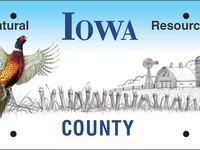On this page...
What is Wildlife Diversity?
Many folks may associate the Iowa DNR almost exclusively with hunting and fishing but the DNR is responsible for all of Iowa’s wildlife; thousands of species that create the unique place that is Iowa! and while a handful of those wildlife are managed using hunting, fishing and trapping, what about the thousands of other species that can not be managed this way? Everything from songbirds, to butterflies, to minnows and turtles?
That’s where the wildlife diversity program comes in and it’s also how we got our name! Our mission is to support and promote the importance of all of the hundreds of diverse “non-game” wildlife species. In short, we work for all wildlife with a goal to maintain a diversity of species in Iowa.
Mission
The wildlife diversity program are stewards and advocates for native wildlife diversity in Iowa. We work to implement Iowa's Wildlife Action Plan, which is a roadmap for wildlife conservation into the future.
Back to topWhat We Do
For a relatively small staff we work with many different wildlife and all over the state! Here is a highlight of some of our more significant programs.
- Multiple Species Inventory and Monitoring
- Volunteer Wildlife Monitoring Program
- Bird Conservation Areas
- Iowa Wildlife Action Plan
- Motus Wildlife Tracking System
- Wildlife Conservation Grants
Support Wildlife Diversity in Iowa
There are many ways you can support the wildlife diversity program and wildlife conservation in Iowa!
- Buy a natural resources license plate - This is one of the primary funding sources for wildlife diversity projects.
- Donate to the tax check-off at tax time - Since 1983, this has been the primary source of funding for the program's operations.
- Donate directly
- Buy a Habitat Stamp
- Become a community scientist - Monitor bald eagle's nests, frogs and toads or bats through the volunteer wildlife monitoring program.
- Learn about our Landowner Assistance Programs - Help protect Iowa land for wildlife diversity and management.
